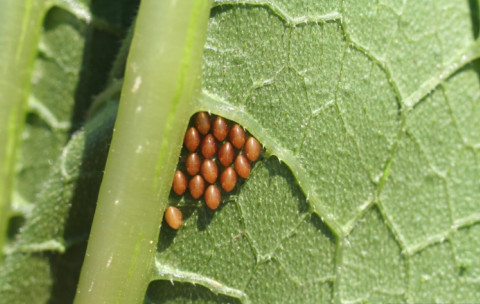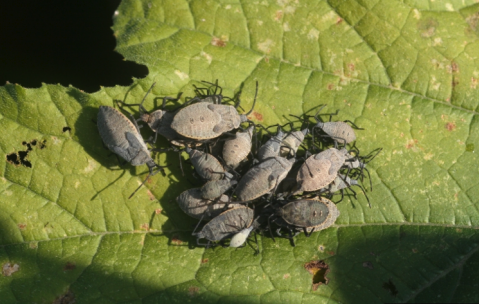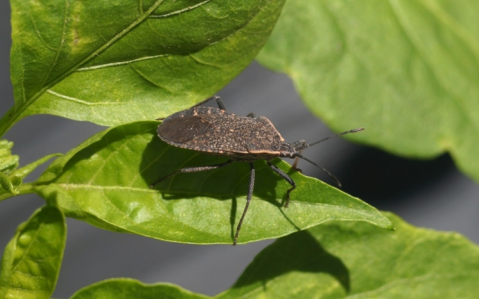Anasa tristis (DeGeer)
Author: Integrated Pest Management Program, University of Georgia, 2020
Description
Immature stages: Eggs are deposited on underside of leaves, but can occasionally be found on upper surface or on leaf petioles. The eggs are elliptical, somewhat flattened and bronze in color. The average egg is 1.5 mm long and 1.1 mm wide. Females deposit about 20 eggs in each cluster. Eggs may be tightly clustered or spread apart, but equidistant spacing arrangement is commonly observed. Egg stage is about seven to nine days. Squash bugs undergo five developmental stages, or instars . The nymph is about 2.5 mm in length and light green in color when it hatches. The nymphal stage requires about 33 days for complete development.The squash bug in its second instar is initially about 3 mm long and light gray. The third, fourth, and fifth instars range from 4-10 mm, and are darker gray. With each molt, nymphs become less hairy, and the thorax and wing pads become more pronounced.
Adult stages: Adults measure 1.4 to 1.6 cm in length and are dark grayish-brown. The edges of the bugs’ abdomens are usually marked with alternating gold and brown spots. Adults survive an average of about 75 to 130 days, depending on availability and quality of food.


Biology
Life Cycle: The average lifespan of squash bugs is six to eight weeks. Squash bugs have two to three generations per year in warmer regions and overwinter as adults. They prefer to overwinter in cucurbit fields under crop debris, clods of soil, and woodpiles.
Damage
The squash bug has been reported to attack nearly all cucurbits, but squash and pumpkin are preferred for laying eggs and support high rates of reproduction and survival. The squash bug causes severe damage by secreting highly toxic saliva into plant tissues. Foliage is the primary site of feeding, but in some cases squash bugs will also feed on fruit.
After a squash bug feeds, the foliage wilts, becomes blackened, and dies; this malady is sometimes called “anasa wilt.” Often an entire plant or section of plant will perish while nearby plants remain healthy. The amount of damage on a plant is directly proportional to density of squash bugs. The squash bug can act as a vector of the bacterium Serratia marcescens that causes cucurbit yellow vine disease, or CYVD, a relatively new problem occurring in cucurbits. This bug not only transmits the pathogen, but harbors it within its body during the winter months when plants are not present.
Management
Squash bug adults are difficult to kill with insecticides. Although adult control can be accomplished if the correct material is selected, it is advisable to target the more susceptible nymphs. If insecticides are to be applied when blossoms are present, it is advisable to use insecticides with little residual activity, and apply insecticides late in the day, when honeybee activity is minimal.
Adult squash bugs prefer larger, more mature plants. Thus, early-planted crops may be especially prone to attack later in the season when squash bug activity is greater. Numbers are also highest on plants during bloom and fruit set. Use of early-planted crops as a trap crop has been proposed, but due to the high value of early season fruit, most growers try to get their main crop to mature as early as possible. The use of squash or pumpkin as a trap crop to protect less preferred host plants such as melons and cucumbers may be effective.
Row covers and netting delay colonization of squash, but bugs quickly invade protected plantings if covers are removed to allow pollination. Removal of crop debris in a timely manner is very important. Squash bugs will often be found feeding on old fruit or in abandoned plantings, so quickly remove plant debris following harvest.
